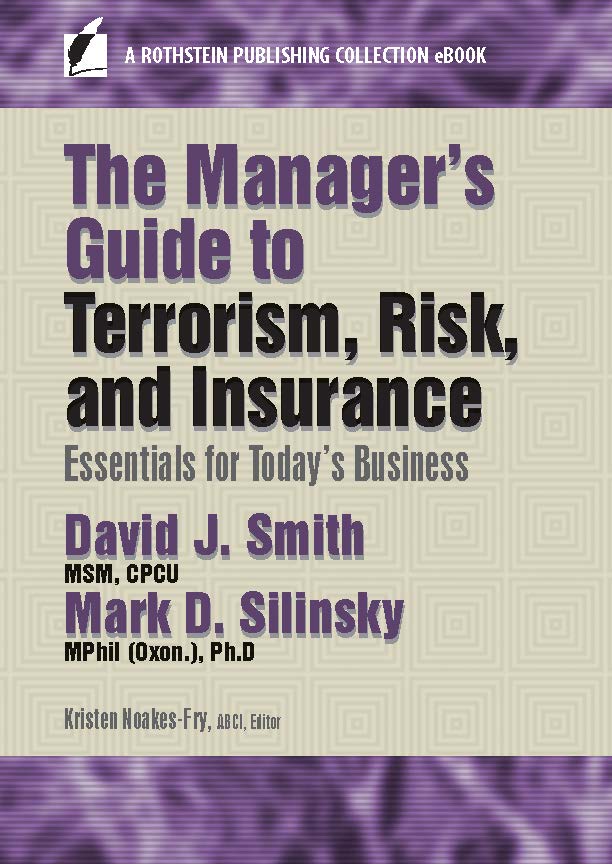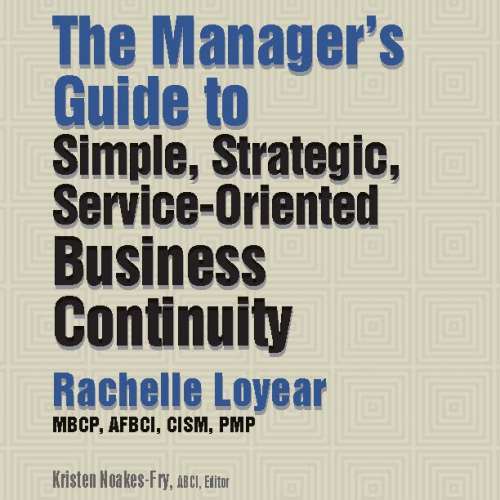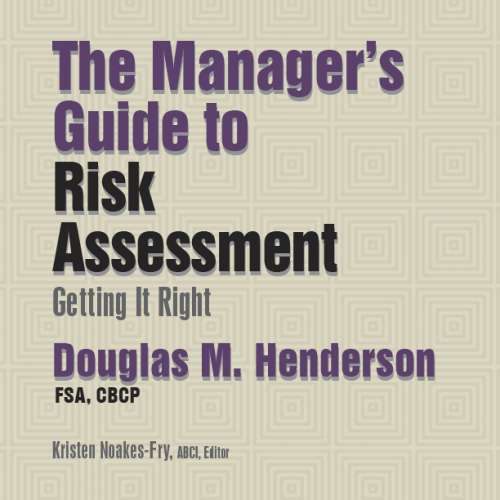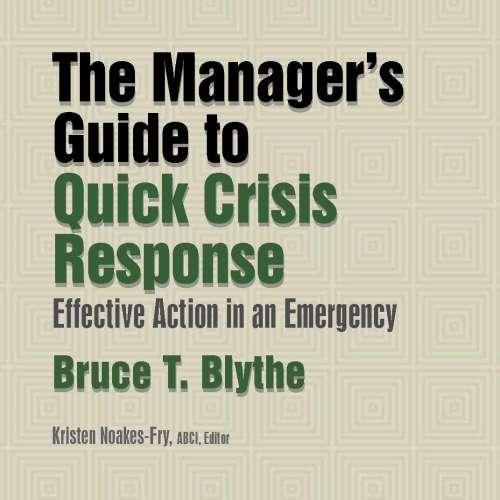Description
What does it take to weigh the likelihood of a terrorism exposure and protect all the assets of your company? The answer to this question involves understanding the nature of terrorists and their behavior, evaluating the risk of potential damage and business interruption, and exploring ways to use insurance – such as programs covered by the US Terrorism Risk Insurance Act – to protect against severe financial harm.
Authors David J. Smith and Mark D. Silinsky give you the benefit of their decades of professional experience in risk management, insurance, physical and cyber security, and anti-terrorism.
This Managers guide to terrorism risk and insurance will help you to better understand:
- Characteristics that could make your company the target of terrorism.
- The most costly terrorist acts that have brought about fatalities and insured property loss.
- How to anticipate the probability of maximum loss and foreseeable loss from terrorism.
- The psychological picture of the typical terrorist – the warning signs and pre-attack indicators.
- Tactics used by terrorists, such as bombings, assassination, and kidnapping.
- Safety measures to be used by employees in the office and as they travel.
- Practical steps for loss reduction from a variety of terrorist-related threats.
- Insurance options to protect against financial loss from destructive terrorist acts, kidnap and ransom, and cyber attack and exposure.
Case studies and discussion questions on terrorism risk are provided to speed your understanding of the material. Importantly, since the book has been extensively researched, the authors provide a wealth of resources that you can consult as you dig deeper into this complex topic.
By David J. Smith (Author), Mark D. Silinsky (Author), Kristen Noakes Fry (Editor), 2016.
About the Authors
David J. Smith, MSM, CPCU
 In 2008, David retired after a 44-year career as an Agent, Senior Underwriter, Product Development Specialist, and Market Intelligence Analyst with the Erie Insurance Group. He is also a retired US Army Military Intelligence Officer who maintained this concurrent career for 22 years. He held Army qualifiers as both Combat Intelligence Officer and Strategic Intelligence Officer. After his retirement, he became the Director of the Risk Management and Insurance Program at Gannon University, where he continues to manage this program. David received a B.A. in Political Science from Gannon College in 1970 and an M.S.M. from the American College in 1995. He received his Chartered Property and Casualty Underwriter (CPCU) designation in 1977 and a graduate diploma from the US Army Command and General Staff College in 1990.
In 2008, David retired after a 44-year career as an Agent, Senior Underwriter, Product Development Specialist, and Market Intelligence Analyst with the Erie Insurance Group. He is also a retired US Army Military Intelligence Officer who maintained this concurrent career for 22 years. He held Army qualifiers as both Combat Intelligence Officer and Strategic Intelligence Officer. After his retirement, he became the Director of the Risk Management and Insurance Program at Gannon University, where he continues to manage this program. David received a B.A. in Political Science from Gannon College in 1970 and an M.S.M. from the American College in 1995. He received his Chartered Property and Casualty Underwriter (CPCU) designation in 1977 and a graduate diploma from the US Army Command and General Staff College in 1990.
Mark D. Silinsky, MPhil (Oxon.), Ph.D
Mark is a 33-year veteran analyst of the US Department of Defense, an adjunct professor at the US Army War College, and an affiliate professor at the University of Haifa. He has served as a Foreign Area Officer (FAO) for Eurasia, Russian language; an Africa analyst for the Defense Intelligence Agency; an action officer for the Joint Staff, J5; and a research fellow in the Exceptional Analyst Program. He graduated Phi Beta Kappa from the University of Southern California; received an MPhil in international relations from Oxford University, under the supervision of Sir Michael Howard; and took a Ph.D. in international development from Tulane University. He was graduated from the National Intelligence University, the Naval War College, a nd the National Defense University. He is the author of The Taliban − Afghanistan’s Most Lethal Insurgent Group, Praeger Press, 2014, and Black Flag over Babylon − The Islamic State and the West, Indiana University Press.
nd the National Defense University. He is the author of The Taliban − Afghanistan’s Most Lethal Insurgent Group, Praeger Press, 2014, and Black Flag over Babylon − The Islamic State and the West, Indiana University Press.
Contents
Cover
Title Page
Copyright
Part 1: What is Terrorism?
1.1 Historical Perspective
1.2 Characteristics of Terrorism
1.3 Terrorist Membership Levels
1.3.1 The Terrorist Cell
1.4 Terrorism in Our Time
1.5 Are There Lessons to Be Learned?
1.6 Defining Terrorism
1.7 Workplace Violence and Terrorism
1.8 Pre-Attack Indicators
1.8.1 Anti-Western Statements, Particularly Those That Involve Any
Element of Your Business
1.8.2 Aggression or Threats Toward Coworkers
1.8.3 Presence of Unauthorized Weapons
1.8.4 Attempts to Communicate with Known Extremist Groups
1.9 An Active Shooter at Work
1.9.1 Evacuate
1.9.2 Have an Escape Route and Plan
1.9.3 Shelter in Place
1.9.4 Take Action Against the Active Shooter
1.9.5 Support First Responder Efforts
1.10 Terrorism and Islam
1.10.1 Sudden Jihad Syndrome
1.11 Terrorism and Mental Health: Are They Crazy?
1.11.1 Signals and Symptoms of the Mentally and Emotionally Troubled
1.11.2 History of Violence
1.11.3 Substance Abuse
1.11.4 Personality Disorders
1.11.5 Nature of Symptoms
1.11.6 Age and Gender
1.11.7 Personal Stress, Crisis, or Loss
1.11.8 Early Exposure to Violence
1.11.9 Psychotics: Lone Actors
1.11.10 Psychopathy
1.12 Is There a Typical Terrorist?
1.13 Anti-Terrorism and the Business Person During Travel
1.13.1 Help from the US Department of State
1.13.2 Preparations for the Businessperson When Traveling
1.14 Surveillance Detection
1.14.1 Stationary Surveillance
1.14.2 Moving Surveillance
1.14.3 Technical Surveillance
1.14.4 Casual Questioning
1.14.5 Detection of Surveillance
1.14.6 False Flag Approach
1.14.7 Business Facility
1.15 Terrorist Tactics
1.15.1 Bombings
1.15.2 Assassination
1.15.3 Kidnapping
1.16 Seven Steps for a Terrorist Attack
1.16.1 Target Selection
1.17 A Matrix for the Traveling Businessperson
1.17.1 In Another Country for an Extended Stay
1.17.2 Residing in Another Country
1.17.3 Visiting a Dangerous Place on Business
1.18 Air Travel Security
1.18.1 General Preparations
1.18.2 Air Travel Planning
1.18.3 At the Terminal
1.18.4 Skyjackings
1.19 Ground Travel Security
1.19.1 Prepare Adequately
1.19.2 Vehicles Overseas
1.19.3 On the Road
1.19.4 An Attack
1.19.5 Parking Your Car
1.20 Off-Duty and Leisure Activities
1.20.1 Basic Measures
1.20.2 Considerations for Using Public Transportation
1.20.3 Considerations for the Use of Taxis
1.21 Conclusion
Case Studies for Chapter 1
References, Chapter 1
Part 2: What is Risk Management?
2.1 Risk, Perils, and Hazards
2.1.1 Risk
2.1.2 Perils
2.1.3 Hazards
2.2 Frequency, Severity, and Terrorism
2.3 Probable Maximum Loss and Maximum Foreseeable Loss
2.4 The Risk Management Process
2.5 Risk Management Techniques
2.5.1 Avoidance
2.5.2 Loss Control
2.5.3 Loss Prevention
2.5.3.1 Barriers
2.5.3.2 Metal Detectors
2.5.3.3 Chemical and Smoke Detectors
2.5.3.4 Lighting
2.5.3.5 Electronic Surveillance
2.5.3.6 Control of Open Areas
2.5.3.7 Unarmed and Armed Guards
2.5.3.8 Air Surveillance and Ground Surveillance Radar Systems
2.5.3.9 Guard Dogs
2.5.3.10 Physical Security Checklists
2.5.3.11 Background Checks on Personnel
2.5.3.12 Social Security Number Checks on Personnel
2.5.3.13 Periodic Re-Evaluation Background Checks on Personnel
2.5.4 Loss Reduction
2.5.4.1 Initial Site Assessment
2.5.4.2 Separation
2.5.4.3 Duplication
2.5.4.4 Chemical, Biological, Radiological, and Nuclear Assessments
2.5.4.5 Local and Central Alarms
2.5.4.6 Emergency Planning and Disaster Recovery
2.5.4.7 Reputation Management
2.5.5 Retention
2.5.6 Transfer
Table 2-1 Top 10 Most Costly Terrorist Acts by Insured Property Losses
Table 2-2 Deadly Terrorist Act Examples by Number of Fatalities
Case Studies, Chapter 2
Discussion Questions, Chapter 2
References, Chapter 2
Appendix A: Insurance Policies Related to Terrorism Risk Management
A.1 The Terrorism Risk Reinsurance Act and Its Successors
A.1.1 The Nature of TRIA
A.1.2 Coverages Provided by TRIA
A.1.3 What TRIA Does Not Include
A.1.4 TRIA Endorsements
A.1.5 The Debate and the Problems with TRIA
A.1.6 Other Options to TRIA
A.2 Kidnap, Ransom, and Extortion (K&R) Insurance Policies
A.2.1 Types of Insurance Companies that Provide K&R Policies
A.2.2 The Coverages Available from K&R Contracts
A.2.3 Contractors Owned by or Employed by K&R Companies
A.3 Cyber Insurance and Cyber Liability Insurance
A.3.1 Cyber Insurance Categories
A.3.2 Current Underwriting Philosophy for Cyber Exposures
A.3.3 Cyber Insurance Limits, Cost, and Content Examples
References, Appendix A
About the Authors
Credits
More from the Publisher
Excerpts
PART 1: What is Terrorism?
Every day you hear the words terrorism and terrorist. These words have different meanings to different people. Some are confused by the terms. This chapter will broadly cover terrorism, as it affects businesses.
In this chapter, you will learn:
- The historical perspective of terrorism.
- How different people define terrorism.
- The interrelationship between terrorism and crime.
- When workplace violence becomes terrorism.
- How terrorism affects business and why businesses are targeted.
- The influence of politics in driving terrorism.
- Mental health issues and personality traits of terrorists.
- Some steps you can take to identify terrorists.
- If it is possible to build a profile with for the “typical” terrorist.
- What defensive measures you can take to reduce the probability of a terrorist attack and mitigate an attack, if it occurs.
- How to behave in an active-shooter situation.
PART 2: What is Risk Management?
Risk Management is the identification, analysis, and treatment of loss exposures. Risk management is something you practice every day. When you drive to work, you try to take a safe route, even if it adds some time to your commute. You may have checked the tires or the windshield wipers. At lunch, you are more likely to avoid a “greasy spoon” restaurant that has been closed down several times for health code violations. You reach the conclusion that the convenience and the low cost is not worth the risk of becoming ill, even though they have tasty burgers. At the office, you probably avoid risky conversation, dressing inappropriately, and leaving too early. When making business decisions, you regularly manage risks and balance them against anticipated returns on investment. Will you risk taking a job offer at another firm and losing seniority in your current firm? And what about the risks you take with your salary? How much will you risk in the stock market? On all these issues, you practice risk management.
Chapter 2 will focus on terrorism and related criminal activity from the perspective of a businessperson. As an executive or entrepreneur, you must practice proper risk management techniques when you weigh the likelihood of a terrorism exposure and evaluate the potential damage and business interruption consequences of an incident caused by this menace.
In this chapter, you will explore risk management through:
- The nature of risk.
- Risk, perils, and hazards.
- Frequency and severity.
- Probable maximum loss.
- The risk management process.
- Risk management techniques.


 In 2008, David retired after a 44-year career as an Agent, Senior Underwriter, Product Development Specialist, and Market Intelligence Analyst with the Erie Insurance Group. He is also a retired US Army Military Intelligence Officer who maintained this concurrent career for 22 years. He held Army qualifiers as both Combat Intelligence Officer and Strategic Intelligence Officer. After his retirement, he became the Director of the Risk Management and Insurance Program at Gannon University, where he continues to manage this program. David received a B.A. in Political Science from Gannon College in 1970 and an M.S.M. from the American College in 1995. He received his Chartered Property and Casualty Underwriter (CPCU) designation in 1977 and a graduate diploma from the US Army Command and General Staff College in 1990.
In 2008, David retired after a 44-year career as an Agent, Senior Underwriter, Product Development Specialist, and Market Intelligence Analyst with the Erie Insurance Group. He is also a retired US Army Military Intelligence Officer who maintained this concurrent career for 22 years. He held Army qualifiers as both Combat Intelligence Officer and Strategic Intelligence Officer. After his retirement, he became the Director of the Risk Management and Insurance Program at Gannon University, where he continues to manage this program. David received a B.A. in Political Science from Gannon College in 1970 and an M.S.M. from the American College in 1995. He received his Chartered Property and Casualty Underwriter (CPCU) designation in 1977 and a graduate diploma from the US Army Command and General Staff College in 1990. nd the National Defense University. He is the author of The Taliban − Afghanistan’s Most Lethal Insurgent Group, Praeger Press, 2014, and Black Flag over Babylon − The Islamic State and the West, Indiana University Press.
nd the National Defense University. He is the author of The Taliban − Afghanistan’s Most Lethal Insurgent Group, Praeger Press, 2014, and Black Flag over Babylon − The Islamic State and the West, Indiana University Press.

